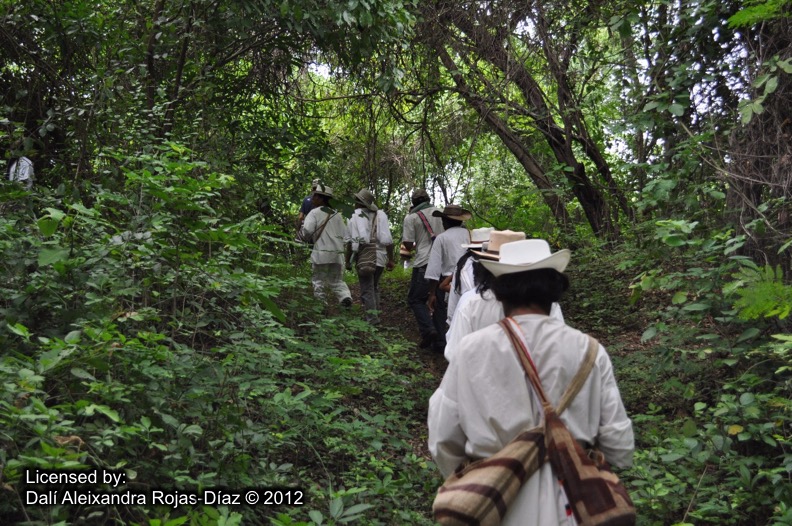
May 22, 2017, by Florelia Vallejo-Trujillo
Intangible Cultural Heritage: A step forward in the Protection of Traditional Knowledge in Colombia
The peoples of Kogi, Wiwa, Arhuaco and Kankuamo from the Sierra Nevada de Santa Marta recently achieved recognition of their ancestral knowledge systems as culturally relevant elements and became an established part of the Colombian Representative List of the Intangible Cultural Heritage. Among others, such ancestral knowledge includes their language and oral traditions, social organisation, the spiritual knowledge associated with their ancestral worldview, and their traditional knowledge. This is not the first time the Colombian Government has sought the protection of traditional knowledge through a different path than the recognition of intellectual property rights. For example, ‘El proceso de formar y vivir como nükak baka (gente verdadera)’ [‘the process of forming and living as a nükak baka (real people)’] and the ‘Hee Yaia Keti Oka, el conocimiento Tradicional (Jaguares de Yuruparí) para el manejo de los grupos indígenas del río Pira Paraná’ [‘Hee Yaia Keti Oka (the traditional knowledge of the jaguars of Yuruparí) for managing the world of the indigenous peoples from the Pira Paraná River’] had previously been included in such national intangible cultural heritage lists. These matters represent an opportunity to verify in practice the effectiveness of alternatives other than the application of intellectual property rights for the protection of traditional knowledge. Safeguarding has been understood as the practice of action, protection, compromise, monitoring and prevention, which allows the recovery and return of peoples’ traditions. For now, partial reports seem to confirm its positive effects in protecting the culture and traditional knowledge of some Colombian indigenous peoples. In general, the strengthening of traditional social organisations, an improvement in the understanding of the logic of the State, and an identification of the individual and collective rights have been reported.
Traditional knowledge is usually understood as the knowledge developed by indigenous and local communities regarding the use and management of the biodiversity located within the territory they live. Although for these communities there is no distinction between the elements comprising their culture, its legal protection has been divided in two aspects: traditional knowledge (already explained), and traditional cultural expressions. This latter category relates to all cultural manifestations which are not directly associated with the use and management of biodiversity. As a result, the protection of Colombian indigenous and local communities’ traditional knowledge was generally excluded from the initiatives to protect their traditional culture. In this regard, the incorporation of the traditional knowledge of different Colombian peoples in the representative list of the Colombian intangible cultural heritage may also be considered as a legal approach closer to the reality in which these indigenous and local communities live.
In practical terms, the inclusion of cultural manifestations in national lists of intangible cultural heritage generates concrete obligations for States. Such duties are derived from the 2003 Convention of UNESCO for the safeguarding of the intangible cultural heritage. This Convention recognises the social and economic value of intangible cultural heritage as well as the risk for certain cultural elements, which could disappear without help. In this context, intangible cultural heritage is acknowledged as those particular cultural components that arouse emotions and make people feel as though they belong to something: a community, a country, or a way of life. It includes tangible objects such as monuments and collections of objects, and immaterial objects, namely oral traditions, festive events and traditional knowledge.
For the protection of cultural heritage, the Convention binds its State Parties with two obligations, first, to take the necessary measures to ensure the safeguarding of the intangible cultural heritage present in their territory, and second, to identify and define, with the participation of the relevant communities and practitioners, the elements of their intangible cultural heritage. This primarily involves the creation of national inventories and the development of action plans for safeguarding the culture of the State. In other words, the inventories, which are expressed in lists, are mechanisms for the safeguarding of intangible heritage. Their relevance is that States can then nominate the heritage comprised in their national lists for its inclusion in one of the Convention’s lists of intangible cultural heritage.
The process is simple enough. The UNESCO’s Intergovernmental Committee for the Safeguarding of the Intangible Cultural Heritage (the Committee) meets annually to evaluate the nominations proposed by States Parties and decides whether or not to inscribe their cultural expressions in one of the Lists of the Convention. These are of two kinds. The first one is the List of Intangible Cultural Heritage in Need of Urgent Safeguarding. It comprises cultural elements considered as requiring urgent measures to keep them ‘alive’. The second is the Representative List of the Intangible Cultural Heritage of Humanity. It regards those elements that help to demonstrate the diversity of this heritage and raise awareness about its importance. On the basis of the proposals submitted by the Member States, the Committee also selects and promotes national, sub-regional and regional programmes, projects and activities for the safeguarding of the intangible cultural heritage. Therefore, the importance for a State of including its cultural heritage in one of these lists is the possibility to receive the UNESCO’s support for its safeguarding.
For the purposes of this particular case, the above means that the inclusion of the ancestral knowledge systems of the peoples of the Sierra Nevada de Santa Marta in the National Representative List of the Intangible Cultural Heritage, generates for the Colombian Government, first, the obligation to create an action plan for its safeguarding. Second, it represents an opportunity for the State and these peoples to receive international support for the achievement of this target, which includes, the protection of their traditional knowledge.
No comments yet, fill out a comment to be the first

Leave a Reply